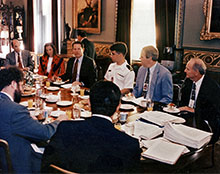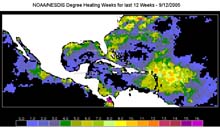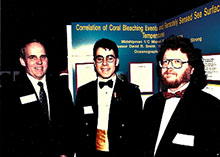Technology and the Study of Coral Reefs: How a Handful of Students Changed the Way NOAA Does Business
The mission of NOAA's Coral Reef Watch Program is to use remote sensing and onsite tools for near real-time and long-term monitoring, modeling, and reporting of physical environmental conditions of coral reef ecosystems. Coral Reef Watch also assists in the management, study, and assessment of environmental impacts on coral reefs.
- Introduction
- The Beginnings
- Breakfast with the VP
- Gaining Momentum
- Program Established
- Where is Coral Reef Watch Now?
- Conclusion
- Works Consulted

Midshipmen Julie Pryor and Michael Gleeson with Visiting Professor Alan Strong, at work in his remote sensing laboratory at the United States Naval Academy (ca. 1994).
Many government programs come to be through legislation, or simply from the glimmer in a bureaucrat's eye. This is not the case in the following story, about how a handful of motivated undergraduates at the United States Naval Academy spearheaded the creation of NOAA's now-vibrant Coral Reef Watch Program. Coral Reef Watch uses high-tech satellite information to inform marine park managers and scientists when corals may be at risk for bleaching, and empowers managers with exciting new tools to communicate to their constituents the short- and long-term changes to coral reef ecosystems around the world.
The Beginnings
In 1986, Dr. Alan Strong took a one-year sabbatical from his position at NOAA to serve on the faculty at the United States Naval Academy. Dr. Strong supervised a group of midshipmen in completing independent satellite oceanography research projects. As his sabbatical ended, NOAA and the Naval Academy asked Dr. Strong to stay longer to expand on the successful collaboration between the two institutions. In the end, Dr. Strong ended up staying at the Naval Academy an additional 11 years.

Photo showing bleached elkhorn coral near St. Croix, U.S. Virgin Islands, in October 2005. Click image for larger view and credit.
By 1989, a relatively new ocean phenomenon called "coral bleaching" was increasingly observed in parts of the Caribbean Sea. The midshipmen working under Dr. Strong's direction became interested in trying to understand this environmental phenomenon using remote sensing. The emergence of this new environmental threat, which leaves corals weakened or dead, together with the interests of his students, led Dr. Strong to begin focusing his research on the causes of coral reef bleaching.
Breakfast with the Vice President

Vice President Al Gore's morning Cabinet briefing in May 1994. Left-to-right facing the camera are Rafe Pomerance (U.S. State Department), Katie McGinty (Vice President Gore's environmental aide), Vice President Al Gore, Midshipman Michael Gleeson, Dr. Alan Strong, and Dr. Peter Glynn. Click image for larger view.
The midshipmen working with Dr. Strong began presenting their satellite data at scientific conferences in the early 1990s. Their research showed that excessively warm sea surface temperatures during the summer appeared linked with the occurrence of coral bleaching events. In 1994, one of the students, Midshipman Michael Gleeson, developed an index for identifying the environmental conditions indicative of past and present bleaching events.
Eventually, Vice President Al Gore, a staunch environmentalist, heard about this research and invited both Dr. Strong and Midshipman Gleeson to breakfast to discuss their work. It became clear that Dr. Strong and company had the Vice President's attention when the planned 15-minute briefing became a lively 90-minute question and answer session. The meeting with Vice President Gore was just one indication of the importance of the research conducted by Dr. Strong and his students.
Coral Reef Watch Gains Momentum
In the mid-1990s, with the advent of the Internet and development of climate information, the Coral Reef Watch Program began to gain momentum and form into what it is today.
Dr. Strong and his students began using the Internet and email for more rapid verification of their remote sensing data, as well as to speed communications about where bleaching was likely to occur. They also developed the necessary satellite-derived sea surface temperature (SST) climatologies. Climatologies are charts that show the average conditions (or the "climate") around the globe for each month of the year.
Data were collected from coral reef scientists in the field that indicated that corals begin to bleach when SSTs during the summer exceed the maximum monthly temperature by only 1 degree Celsius. In other words, corals began to bleach when the temperature of the ocean surface exceeds the average for the typically warmest month by only one degree Celsius.
One of Dr. Strong's students, with assistance from programmers at NOAA's National Environmental Satellite, Data and Information Service, took these data and produced an online experimental chart that showed where these areas of high SSTs were found in real-time across the tropics. In this case, "real time" means that the data were obtained by satellites and made available over the Internet within a couple of hours. These high temperature areas were called "HotSpots." Today, the Coral Reef Watch Program automatically generates HotSpot charts twice each week.

This HotSpot image from September 5, 1998, shows the areas of thermal stress (anomalously high SSTs) during a bleaching event in the western Pacific Ocean. The scale shows the intensity of the stress: areas at risk for bleaching are shown in orange and red. Click image for larger view.
Unfortunately, water temperatures remained excessively warm throughout much of the 1990s, not only in the Caribbean, but also around the globe. Consequently, the bleaching notifications by Email quickly gained an audience of coral reef scientists around the world. Email also provided a means for rapid feedback from managers and scientists on the accuracy of NOAA's satellite observations, providing increasingly rapid assessments to help pinpoint bleaching events. This feedback provided insight about the time lag between high SSTs and the reporting of visible bleaching events from local observers, which was about three to four weeks. At about the same time, researchers became aware of another relationship between water temperature and bleaching: the length of time that the SSTs were elevated above the "critical" temperature affected both the severity and impact of bleaching events.

Degree Heating Weeks (DHW) chart from September 12, 2005, showing the thermal stress during the record-breaking 2005 bleaching event in the Caribbean. DHW charts depict the cumulative thermal stress experienced by an area over a 12-week period. Orange to purple indicates areas of persistently high SSTs, where corals may be experiencing severe bleaching. Click image for larger view.
Another of Dr. Strong's students continued to build on this information, eventually developing the precursor to the "Degree Heating Weeks" (DHW) chart. In a DHW chart, the twice-weekly HotSpot charts from a 12-week period are accumulated into a single chart. This chart shows where bleaching is likely to develop and its potential severity from extended excessive thermal stress. In the late 1990s, the DHW charts became another NOAA experimental online product. Today, these charts are produced twice weekly along with the widely accepted HotSpot charts.
Coral Reef Watch Program is Established
An unprecedented bleaching event in 1998 not only allowed Dr. Strong and his students to fine-tune and test their tools, but also provided a global market for what soon became truly operational satellite products (versus experimental products). Using satellite SSTs from 1985 to the present, Dr. Strong and his students produced monthly and annual composites of both HotSpots and DHWs that revealed past bleaching events, some of which went largely unreported until that time. The 1998 bleaching placed increased attention on corals at NOAA and around the world played an important role in providing high visibility to these new satellite tools.

Midshipman Richard Montgomery stands beside his poster presentation at The Oceanography Society conference in St. Petersburg, Florida, in 1990. His was the first major presentation to highlight areas of bleaching in Bermuda.
Later the same year, Dr. Strong was "recalled" from the Naval Academy to help develop and later direct the Coral Reef Watch Program at NOAA. Upon his departure, Dr. Strong received the Navy Medal for Meritorious Civilian Service. He played a role in several international forums that were instrumental in promoting these satellite tools to coral reef managers. Since that time, Coral Reef Watch's satellite tools have been in demand around the world. In addition, Coral Reef Watch expanded these products, especially for reef managers, by focusing on HotSpots and DHWs at 24 representative coral reef locations in the tropics. These data were called "Tropical Ocean Coral Bleaching Indices."
Also in 1998, President Clinton issued an Executive Order that created the U.S. Coral Reef Task Force,. As a partial response, NOAA and Congress, through the authority of the U.S. Coral Reef Task Force, provided the funds to establish an integrated coral reef research program, called NOAA's Coral Reef Conservation Program. This program allowed NOAA's National Environmental Satellite, Data and Information Service to further develop coral reef satellite products and add several scientists to the Coral Reef Watch Program. NOAA thus began to address the increased need for more and improved satellite remote sensing tools for monitoring coral reefs both domestically and globally.
Where is Coral Reef Watch Now?
In July 2005, Coral Reef Watch added another new operational product to the HotSpot suite. This newest product is called a "Satellite Bleaching Alert" or SBA. Based on satellite near-real-time HotSpot levels, Coral Reef Watch issues four levels of alerts for 24 reef sites in the tropics. Like a tornado watch or warning from NOAA's National Weather Service, Satellite Bleaching Alerts progress from lower to higher levels of certainty, starting with "Bleaching Watch," and moving to "Bleaching Warning," "Bleaching Alert Level 1," and ultimately "Bleaching Alert Level 2." An automatic Email alert is sent to subscribers each time the alert status changes. The SBA is a free tool for coral reef managers, scientists, and others; Coral Reef Watch will continue to add coral reefs sites in the years ahead.
The Coral Reef Watch operational product suite—HotSpots, Degree-Heating Weeks, Tropical Ocean Coral Bleaching Indices, and Satellite Bleaching Alerts—are constantly improving. The Coral Reef Watch team is working to increase the resolution of the current products, add more reef sites to the Satellite Bleaching Alert system, and develop the ability to forecast coral bleaching events.
Conclusion

Midshipman Michael Gleeson stands in front of his award-winning poster at the United States Naval Academy Trident Scholars Awards Banquet in April 1994 with Professors Alan Strong and David Smith (USNA Oceanography Department). Later that year, Midshipman Gleeson won the American Meteorological Society's 1st place student award for best paper.
While it may not be possible to prevent the conditions that lead to coral bleaching, there are things that can be done to minimize damage to corals during bleaching events. For example, managers can restrict potentially stressful activities, such as diver access and fishing on the reef; artificially shade or cool selected reefs to lessen the bleaching impacts; or remove predators from the area to allow corals to recover. To make these measures most effective, coral reef managers must be aware that a bleaching event is taking place, so they can act to protect corals from the long-term effects of bleaching. Herein lies the power of NOAA's Coral Reef Watch Program.
What began two decades ago as an undergraduate research project has become NOAA's Coral Reef Watch, which has fast become a major conservation tool for coral reef managers. Thanks to the dedication and hard work of a handful of undergraduate students at the Naval Academy and their mentor Dr. Alan Strong, coral reef managers now have an early warning monitoring system to alert them of episodes of coral reef bleaching. This knowledge is critical for the long-term survival of the nation's beautiful and valuable coral reefs.
Works Consulted
Gleeson, M.W. & Strong, A.E. (1995). Applying MCSST to coral reef bleaching. Adv. Space Res., 16(10): 10151-10154.
Goreau, T.J., & Hayes, R.L. (1994). Coral bleaching and ocean “hot spots.” Ambio, 23: 176-180.
Montgomery, R.S. & Strong, A.E. (1994). Coral bleaching threatens ocean life. EOS, 75:145-147.
Strong, A.E., Barrientos, C.S., Duda, C., & Sapper, J. (1997). Improved satellite techniques for monitoring coral reef bleaching. Proceedings, 8th International Coral Reef Symposium, 2: 1495-1498.
Strong, A.E., Arzayus, F., Skirving, W., & Heron, S. (2006). Identifying coral bleaching remotely via Coral Reef Watch – Improved integration and implications for changing climate. In J.T. Phinney, A.E. Strong, W. Skirving, J. West, J. Klepas, O. Hoegh-Guldberg (Eds.), Corals and Climate Change: Science and Management, Coastal and Estuarine Series (V. 61). Washington, DC: AGU.
Wellington, G.M., Glynn, P.W., Strong, A.E., Navarrete, S. & Wieters, E. (2001). Crisis on coral reefs linked to climate change. EOS, 82(1): 1 and 5.
Wilkinson, C., Linden, O., Cesar, H., Hodgson, G., Rubens, J. & Strong, A. E. (1999). Ecological and sociological impacts of 1998 coral mortality in the Indian Ocean: an ENSO impact and a warning of future change? Ambio, 28: 188-196.
